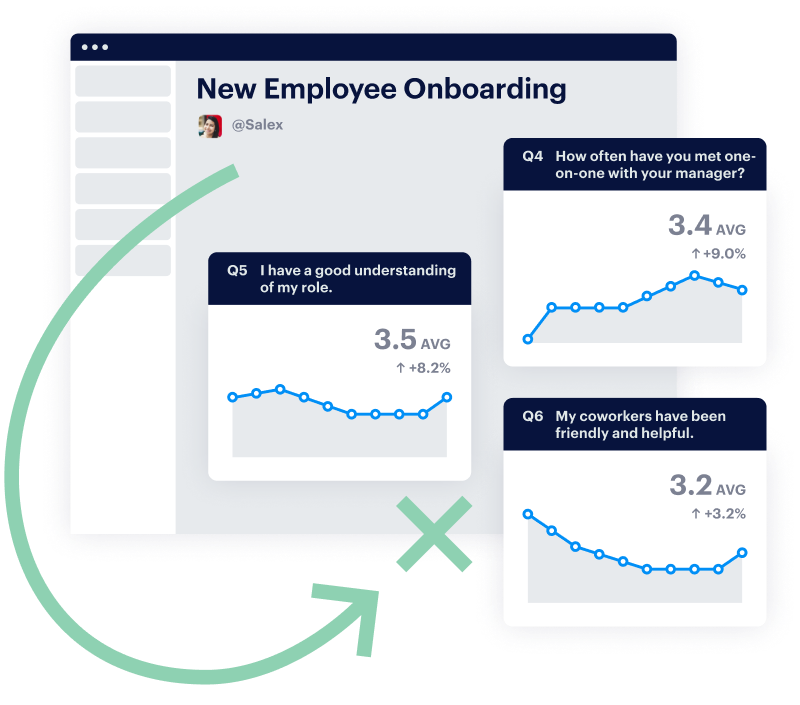Most of us are familiar with employee engagement surveys — a way to collect insights and measure engagement. While they’re useful, they’re also a source of frustration for users.
Too often they’re long and complicated, which means they require too much of our team members’ energy to complete. Those difficulties can lead to people not engaging with your employee surveys.
Create a better experience for everyone and get more promising results with a fresh alternative — the pulse survey.
Let’s explore pulse surveys in detail. We’ll cover:
- What a pulse survey is
- Employee pulse surveys vs employee engagement surveys
- Benefits of pulse surveys
- Tips to help you run better pulse surveys
What is a pulse survey?
A pulse survey is one of the best ways to measure employee engagement. These short, snappy surveys are made of a handful of questions (usually 1-5) and sent to employees on a weekly or bi-weekly basis. As they’re easy to complete and happen frequently, they help you collect more data and measure trends over time.
Pulse survey questions are simple and straightforward. Here are some examples:
- How are you feeling this week?
- Are you happy at work?
- How connected do you feel to your team this week?
- What’s your main focus right now?
- Is your workload currently manageable?
- What are you excited about working on this week?
- What would you like more support with?
One of the simplest yet most effective uses for a pulse survey is to measure employee or team happiness. You can also use a modified version to check in with people through times of change — like onboarding, moving to a new role, coming back from a sabbatical, or stepping into a management role.
Employee pulse surveys vs employee engagement surveys
Quarterly or annual engagement surveys and pulse surveys are both tools to help you measure employee experience and gather useful data to guide change. While they have a similar purpose, they achieve this in different ways.
Traditional annual surveys are usually:
- 🕗 Lengthy, often with 20+ questions
- ❓ Filled with open-ended questions
- 📚 Based on lots of topic areas — ex., culture, remote work, and job satisfaction
- 📅 Run once a quarter or year
- 🙁 Hard to focus on for a long time
- 🖼️ A snapshot of employee sentiment at a defined period of time
In contrast, pulse surveys are typically:
- ✅ Quick to complete, often with 1-5 questions
- ❔ Made of short questions with multiple-choice answers
- 📗 Based on a specific topic — e.g. employee happiness or new employee engagement
- 🔁 Run frequently, on a regular basis
- 🙂 More engaging
- 🍊 A source of fresh, accurate results that create an ongoing data trend
Employee engagement benefits of pulse surveys
 There are many great reasons why you should use pulse surveys as part of your approach to employee engagement. With pulse surveys, you can:
There are many great reasons why you should use pulse surveys as part of your approach to employee engagement. With pulse surveys, you can:
Get fast data
It’s much quicker to complete a pulse survey than a traditional employee engagement survey — especially if you use Polly to collect that data in-context. This means you can capture someone's attention and their employee feedback much faster, without them having to leave Slack or Teams.
Identify challenges quickly
The immediate results you get from pulse surveys gives you an unbeatable way to spot challenges and problems now, so you can act on them more quickly. A snappy weekly or monthly survey cadence gives you the chance to pick up problems early for the best possible resolution.
Watch trends over time
Running pulse surveys often doesn’t just help you see problems ahead, but it also helps you monitor changes and trends. Your first survey gives you a benchmark that you can match others against to see overall positive and negative trends in employee satisfaction or engagement. Spotting trends offers you valuable insights to help you make strategic decisions.
Drive higher response rates
It’s tough to get people to engage with a traditional employee survey. With so many questions and topics, it’s easy for people to get survey fatigue and give up or share unreliable responses.
Our research found that survey response rates and engagement levels rose by 7-10x when our customers switched to sending shorter pollys, compared to a 26% engagement rate on traditional surveys. Embracing pulse surveys is a sure-fire way to increase employee participation, so you can get better data and reinforce your company culture.
Create a positive habit
Habits are formed through repetition, and one survey every year doesn’t lend itself to habit forming. With frequently sent pulse surveys, your employees can build a positive habit of completing their survey when they see it. This instant response provides you with accurate data, gives your employees an easy way to be heard, and helps them stay engaged.
Support a culture of feedback
Feedback, both positive and negative, is at the center of any forward-thinking organization. We all need feedback to help us improve, and pulse surveys are one way of getting valuable information to help you shape your company for the better. Use a tool like Polly to help you make feedback part of your company culture and create the best possible employee experience.
7 tips to help you run better pulse surveys
 We know that pulse surveys can be a powerful tool to help you measure employee engagement, experience, and happiness. Though they’re useful on their own, improving the way you run your pulse surveys can help you get even better results. Here’s how to optimize your pulse surveys:
We know that pulse surveys can be a powerful tool to help you measure employee engagement, experience, and happiness. Though they’re useful on their own, improving the way you run your pulse surveys can help you get even better results. Here’s how to optimize your pulse surveys:
1. Set a clear goal
Know what you want your surveys to achieve before you run them. Think about what metrics you want to measure — like how often someone participates, or how the overall score changes over time. Once you know your goal, you can begin to roll out pulse surveys.
2. Get buy-in from everyone
Only the most engaged employees will complete pulse surveys without any buy-in from the top. Motivate everyone to take part by leading from the top, with your senior and HR leaders paving the way for a culture shift towards participating. The more higher-ups talk about how easy it is to complete pulse surveys and why they matter, the more others will be encouraged to join in.
3. Keep your pulse survey questions consistent
The best way to monitor trends is to keep your pulse survey questions the same. Repeat the same question and response options every time you send a specific questionnaire (like a weekly pulse check-in, or an onboarding check-in), so you can easily compare results from one survey to the next.
4. Welcome feedback about your pulse surveys
If you’ve just started running pulse surveys, chances are there’s some room for improvement. Encourage respondents to share feedback on previous surveys, then review that feedback. Follow up with them afterwards so they know they’ve been heard, and change your future surveys so they’re more relevant and helpful.
5. Move fast with the survey data you receive
People will soon stop completing your pulse surveys if they don’t see any changes happen as a result. Once you have the data you need, take action. For example, if you notice that people aren’t feeling engaged with their team, host a fun, virtual event like a trivia game to bring them together. Create an action plan based on the trends you’re seeing, and share your ideas and initiatives with everyone as you take the next steps.
6. Monitor changes to see the impact of initiatives
Pulse surveys are especially useful, as they let you monitor changes over time. Use this feature to help you see if there’s a shift in sentiment or engagement after you introduce new culture initiatives, change your onboarding process, or implement ways to help you increase employee retention. The changes here will give you an insight into whether your actions and tactics have had the desired impact or not.
7. Use the right pulse survey software
One of the best ways to make an impact with your surveys is to choose the right pulse survey tool. With an engagement app like Polly, you can create, run, and schedule pulse surveys in Slack and Teams easily — and effectively monitor their results. Our pulse survey templates give you a quick way to get started, but you can always modify the questions to match your goals and intentions.
Use pulse surveys to transform the employee experience
Pulse surveys present you with a fresh, effective alternative to the traditional employee engagement survey. With this tool, you can understand your employees’ needs and wants in just a few questions and measure changes over time to make a real difference.
The right tools can help you create more engaging experiences with your employees. Try Polly today for a better way to support your employee engagement strategy with pulse surveys, instant pollys, and more.

Written by Nicola Scoon
Nicola Scoon is a freelance writer that's passionate about employee engagement and better workplace experiences. She draws on her experience in internal communications to help companies create content that empowers, encourages, and motivates people to create better experiences for all.







